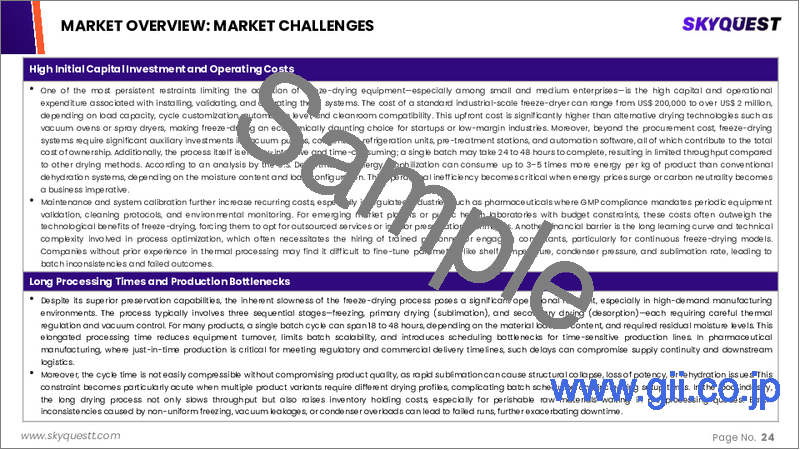|
|
市場調査レポート
商品コード
1655942
凍結乾燥装置の市場規模、シェア、成長分析:製品別、付属品別、用途別、地域別 - 産業予測 2025~2032年Freeze-Drying Equipment Market Size, Share, and Growth Analysis, By Product (Bench Top Freeze Dryers, Laboratory Freeze Dryers), By Accessories (Loading and Unloading Systems, Vacuum Systems), By Application, By Region - Industry Forecast 2025-2032 |
||||||
|
|||||||
| 凍結乾燥装置の市場規模、シェア、成長分析:製品別、付属品別、用途別、地域別 - 産業予測 2025~2032年 |
|
出版日: 2025年02月12日
発行: SkyQuest
ページ情報: 英文 202 Pages
納期: 3~5営業日
|
全表示
- 概要
- 目次
フリーズドライ装置の世界市場規模は2023年に25億米ドルと評価され、2024年の26億7,000万米ドルから2032年には44億8,000万米ドルに成長し、予測期間(2025-2032年)のCAGRは6.7%で成長する見通しです。
世界のフリーズドライ装置市場は、優れた保存技術を必要とする加工食品や簡便食品に対する消費者需要の高まりによって力強い成長を遂げています。フリーズドライは冷蔵や化学添加物を使用せずに製品の保存期間を延長するため、食品メーカーだけでなく、敏感な医薬品、ワクチン、生物学的サンプルの保存にこの技術を利用している製薬部門にも魅力的です。自動化され制御されたシステムなどの進歩により、フリーズドライプロセスの効率が向上しています。さらに、研究や現場環境では、コンパクトで持ち運び可能なフリーズドライ装置の需要が高まっています。しかし、初期投資コストの高さ、時間のかかるプロセス、フリーズドライに関わる複雑な変数を管理する熟練オペレーターの必要性などの課題も残っています。
目次
イントロダクション
- 調査の目的
- 調査範囲
- 定義
調査手法
- 情報調達
- 二次と一次データの方法
- 市場規模予測
- 市場の前提条件と制限
エグゼクティブサマリー
- 世界市場の見通し
- 供給と需要の動向分析
- セグメント別機会分析
市場力学と見通し
- 市場概要
- 市場規模
- 市場力学
- 促進要因と機会
- 抑制要因と課題
- ポーターの分析
主な市場の考察
- 重要成功要因
- 競合の程度
- 主な投資機会
- 市場エコシステム
- 市場の魅力指数(2024年)
- PESTEL分析
- マクロ経済指標
- バリューチェーン分析
- 価格分析
- 規制情勢
- ケーススタディ
- 技術の進歩
フリーズドライ装置市場規模:製品別& CAGR(2025-2032)
- 市場概要
- 据え置き型フリーズドライ機
- 実験室用フリーズドライ機
- 移動式フリーズドライ機
- 汎用フリーズドライ機
- 産業用フリーズドライ機
- その他
フリーズドライ装置市場規模:アクセサリー別& CAGR(2025-2032)
- 市場概要
- 積み込みおよび積み下ろしシステム
- 真空システム
- 監視制御システム
フリーズドライ装置市場規模:用途別& CAGR(2025-2032)
- 市場概要
- バイオテクノロジー
- 医薬品
- 食品加工
- 外科手術
- その他
フリーズドライ装置市場規模:地域別& CAGR(2025-2032)
- 北米
- 米国
- カナダ
- 欧州
- ドイツ
- スペイン
- フランス
- 英国
- イタリア
- その他欧州地域
- アジア太平洋地域
- 中国
- インド
- 日本
- 韓国
- その他アジア太平洋地域
- ラテンアメリカ
- ブラジル
- その他ラテンアメリカ地域
- 中東・アフリカ
- GCC諸国
- 南アフリカ
- その他中東・アフリカ
競合情報
- 上位5社の比較
- 主要企業の市場ポジショニング(2024年)
- 主な市場企業が採用した戦略
- 最近の市場動向
- 企業の市場シェア分析(2024年)
- 主要企業の企業プロファイル
- 企業の詳細
- 製品ポートフォリオ分析
- 企業のセグメント別シェア分析
- 収益の前年比比較(2022-2024)
主要企業プロファイル
- Buhler Group(Switzerland)
- Glatt Group(Germany)
- IMA Life S.r.l(Italy)
- GEA Group(Germany)
- Martin Christ Gefriertrocknungsanlagen GmbH(Germany)
- Millrock Technology, Inc.(USA)
- RheaVita(Belgium)
- Biopharma Process Systems Ltd.(UK)
- Cuddon Freeze Dry(New Zealand)
- Cryotec Fr(France)
- SP Industries, Inc.(USA)
- Labconco Corporation(USA)
- Tofflon Science and Technology Group Co., Ltd.(China)
- OPTIMA packaging group GmbH(Germany)
- HOF Sonderanlagenbau GmbH(Germany)
- Azbil Telstar, S.L.(Spain)
- Lyophilization Systems India Pvt. Ltd.(India)
- Zirbus Technology GmbH(Germany)
- BPS Crowthorne Ltd.(UK)
- Freezedry Specialties, Inc.(USA)
結論と提言
Global Freeze-Drying Equipment Market size was valued at USD 2.5 billion in 2023 and is poised to grow from USD 2.67 billion in 2024 to USD 4.48 billion by 2032, growing at a CAGR of 6.7% during the forecast period (2025-2032).
The global freeze-drying equipment market is witnessing robust growth driven by rising consumer demand for processed and convenience foods, necessitating superior preservation techniques. Freeze-drying extends the shelf life of products without refrigeration or chemical additives, appealing not only to food manufacturers but also to the pharmaceutical sector, which relies on this technology for the preservation of sensitive drugs, vaccines, and biological samples. Advancements such as automated and controlled systems are enhancing efficiency in the freeze-drying process. Additionally, there is a heightened demand for compact, portable freeze-drying units in research and field settings. However, challenges persist, including high initial investment costs, time-consuming processes, and the need for skilled operators to manage the intricate variables involved in freeze-drying.
Top-down and bottom-up approaches were used to estimate and validate the size of the Global Freeze-Drying Equipment market and to estimate the size of various other dependent submarkets. The research methodology used to estimate the market size includes the following details: The key players in the market were identified through secondary research, and their market shares in the respective regions were determined through primary and secondary research. This entire procedure includes the study of the annual and financial reports of the top market players and extensive interviews for key insights from industry leaders such as CEOs, VPs, directors, and marketing executives. All percentage shares split, and breakdowns were determined using secondary sources and verified through Primary sources. All possible parameters that affect the markets covered in this research study have been accounted for, viewed in extensive detail, verified through primary research, and analyzed to get the final quantitative and qualitative data.
Global Freeze-Drying Equipment Market Segments Analysis
Global Freeze-Drying Equipment Market is segmented by Product, Accessories, Application and region. Based on Product, the market is segmented into Bench top freeze dryers, Laboratory freeze dryers, Mobile freeze dryers, General purpose freeze dryers, Industrial freeze dryers and Others. Based on Accessories, the market is segmented into Loading and Unloading Systems, Vacuum Systems and Monitoring and Control Systems. Based on Application, the market is segmented into Biotechnology, Pharmaceuticals, Food processing, Surgical procedures and Others. Based on region, the market is segmented into North America, Europe, Asia Pacific, Latin America and Middle East & Africa.
Driver of the Global Freeze-Drying Equipment Market
The Global Freeze-Drying Equipment market is driven by the increasing adoption of lyophilization technology, which is utilized to preserve an array of food products such as fruits, vegetables, meats, fish, herbs, culinary flavorings, ice creams, and coffee. This method eliminates the necessity for refrigeration and chemical preservatives, offering a longer shelf life while retaining the nutritional quality and flavor of the food. Additionally, freeze-dried items can be easily rehydrated simply by adding water, facilitating quick and convenient preparation for consumers. As a result, the demand for freeze-drying equipment continues to grow in response to these benefits.
Restraints in the Global Freeze-Drying Equipment Market
The Global Freeze-Drying Equipment market faces significant constraints due to incomplete moisture removal during the lyophilization process. This inefficiency can leave products with excessive moisture, increasing the risk of contamination and potentially endangering patients who rely on these products. The market report offers an extensive overview of this sector, detailing recent advancements, regulatory frameworks, trade dynamics, production insights, and value chain optimization. It also analyzes market share distribution, the influence of both domestic and international players, and opportunities arising in emerging sectors. Additionally, it covers changes in market regulations, strategic growth analysis, trends in specific categories, product launches, geographic expansions, and technological innovations.
Market Trends of the Global Freeze-Drying Equipment Market
The Global Freeze-Drying Equipment market is experiencing significant growth, primarily fueled by the burgeoning demand from the pharmaceutical sector. As the need to preserve sensitive drugs, vaccines, and biological samples intensifies, pharmaceutical companies are increasingly embracing freeze-drying technology to enhance product stability and extend shelf life. This trend is driving investments in advanced freeze-drying solutions, leading to innovations in equipment design and efficiency. Additionally, the rising focus on biopharmaceutical development and the growing emphasis on quality control further contribute to the market's expansion, positioning freeze-drying as a critical process in modern pharmaceutical manufacturing and storage practices.
Table of Contents
Introduction
- Objectives of the Study
- Scope of the Report
- Definitions
Research Methodology
- Information Procurement
- Secondary & Primary Data Methods
- Market Size Estimation
- Market Assumptions & Limitations
Executive Summary
- Global Market Outlook
- Supply & Demand Trend Analysis
- Segmental Opportunity Analysis
Market Dynamics & Outlook
- Market Overview
- Market Size
- Market Dynamics
- Drivers & Opportunities
- Restraints & Challenges
- Porters Analysis
- Competitive rivalry
- Threat of substitute
- Bargaining power of buyers
- Threat of new entrants
- Bargaining power of suppliers
Key Market Insights
- Key Success Factors
- Degree of Competition
- Top Investment Pockets
- Market Ecosystem
- Market Attractiveness Index, 2024
- PESTEL Analysis
- Macro-Economic Indicators
- Value Chain Analysis
- Pricing Analysis
- Regulatory Landscape
- Case Studies
- Technological Advancement
Global Freeze-Drying Equipment Market Size by Product & CAGR (2025-2032)
- Market Overview
- Bench top freeze dryers
- Laboratory freeze dryers
- Mobile freeze dryers
- General purpose freeze dryers
- Industrial freeze dryers
- Others
Global Freeze-Drying Equipment Market Size by Accessories & CAGR (2025-2032)
- Market Overview
- Loading and Unloading Systems
- Vacuum Systems
- Monitoring and Control Systems
Global Freeze-Drying Equipment Market Size by Application & CAGR (2025-2032)
- Market Overview
- Biotechnology
- Pharmaceuticals
- Food processing
- Surgical procedures
- Others
Global Freeze-Drying Equipment Market Size & CAGR (2025-2032)
- North America (Product, Accessories, Application)
- US
- Canada
- Europe (Product, Accessories, Application)
- Germany
- Spain
- France
- UK
- Italy
- Rest of Europe
- Asia Pacific (Product, Accessories, Application)
- China
- India
- Japan
- South Korea
- Rest of Asia-Pacific
- Latin America (Product, Accessories, Application)
- Brazil
- Rest of Latin America
- Middle East & Africa (Product, Accessories, Application)
- GCC Countries
- South Africa
- Rest of Middle East & Africa
Competitive Intelligence
- Top 5 Player Comparison
- Market Positioning of Key Players, 2024
- Strategies Adopted by Key Market Players
- Recent Developments in the Market
- Company Market Share Analysis, 2024
- Company Profiles of All Key Players
- Company Details
- Product Portfolio Analysis
- Company's Segmental Share Analysis
- Revenue Y-O-Y Comparison (2022-2024)
Key Company Profiles
- Buhler Group (Switzerland)
- Company Overview
- Business Segment Overview
- Financial Updates
- Key Developments
- Glatt Group (Germany)
- Company Overview
- Business Segment Overview
- Financial Updates
- Key Developments
- IMA Life S.r.l (Italy)
- Company Overview
- Business Segment Overview
- Financial Updates
- Key Developments
- GEA Group (Germany)
- Company Overview
- Business Segment Overview
- Financial Updates
- Key Developments
- Martin Christ Gefriertrocknungsanlagen GmbH (Germany)
- Company Overview
- Business Segment Overview
- Financial Updates
- Key Developments
- Millrock Technology, Inc. (USA)
- Company Overview
- Business Segment Overview
- Financial Updates
- Key Developments
- RheaVita (Belgium)
- Company Overview
- Business Segment Overview
- Financial Updates
- Key Developments
- Biopharma Process Systems Ltd. (UK)
- Company Overview
- Business Segment Overview
- Financial Updates
- Key Developments
- Cuddon Freeze Dry (New Zealand)
- Company Overview
- Business Segment Overview
- Financial Updates
- Key Developments
- Cryotec Fr (France)
- Company Overview
- Business Segment Overview
- Financial Updates
- Key Developments
- SP Industries, Inc. (USA)
- Company Overview
- Business Segment Overview
- Financial Updates
- Key Developments
- Labconco Corporation (USA)
- Company Overview
- Business Segment Overview
- Financial Updates
- Key Developments
- Tofflon Science and Technology Group Co., Ltd. (China)
- Company Overview
- Business Segment Overview
- Financial Updates
- Key Developments
- OPTIMA packaging group GmbH (Germany)
- Company Overview
- Business Segment Overview
- Financial Updates
- Key Developments
- HOF Sonderanlagenbau GmbH (Germany)
- Company Overview
- Business Segment Overview
- Financial Updates
- Key Developments
- Azbil Telstar, S.L. (Spain)
- Company Overview
- Business Segment Overview
- Financial Updates
- Key Developments
- Lyophilization Systems India Pvt. Ltd. (India)
- Company Overview
- Business Segment Overview
- Financial Updates
- Key Developments
- Zirbus Technology GmbH (Germany)
- Company Overview
- Business Segment Overview
- Financial Updates
- Key Developments
- BPS Crowthorne Ltd. (UK)
- Company Overview
- Business Segment Overview
- Financial Updates
- Key Developments
- Freezedry Specialties, Inc. (USA)
- Company Overview
- Business Segment Overview
- Financial Updates
- Key Developments





